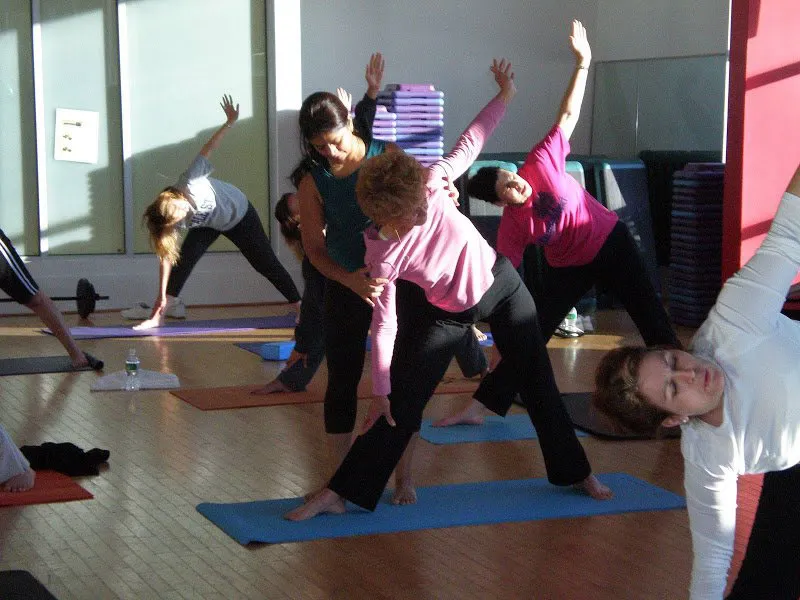How the $80 billion business of yoga is a win-win game for mind and pocket
For the past three mornings, I have been reminded by the government of India to practice yoga (with a capital Y). I am told it will make me “feel active, energetic and positive,” and that I should “live life to its full potential.”
Like me, the approx 900 million mobile phone users of India have received a similar message and have woken up feeling annoyed, amused, guilty or righteous depending upon where their allegiance lies. It pays to have more mobile phones than toilets, I guess.
Today, however, is special. Besides being the longest day in the year, June 21 has been designated as the International Yoga Day by the United Nations. Prime Minister Narendra Modi’s impassioned speech at the UN Assembly in September last year proposing to dedicate a day to yoga, which has been India’s greatest gift to the world, brought in the required resolution within the shortest possible time. Along with India, 177 nations will commemorate the day with perhaps a collective Surya Namaskar, tying the world as one big family -- Vasudhaiva Kutumbakam – so to speak.

The 'hijacking' by the government of this traditional practice, which has been a part of the country for centuries, is far from being just a gimmick. It makes business sense. Worldwide, yoga is estimated to be an $80 billion industry.
According to the government's Make In India report, the wellness industry in India is worth INR 490 billion, and wellness services alone comprise 40 percent of the market. The AYUSH sector (Ayurveda, Yoga, Naturopathy, Unani, Siddha and Homoeopathy) has an annual turnover of around INR 120 billion. The sector is dominated by micro, small and medium enterprises, accounting for more than 80 percent of the enterprises.
The government has set up a dedicated Department of AYUSH (which incidentally is the one sending you the early morning messages) with the aim of providing impetus to these ancient healthcare systems, and opportunities for investment, education and research, health services and training in the AYUSH sector.
The products market is worth about INR 40 billion with over-the-counter products such as digestives, health food and pain balms constituting almost 75 percent of the segment. India has 9,000 units engaged in the manufacture of AYUSH drugs. In 2013-2014, AYUSH exports amounted to INR 22.7 billion. Of the exports, raw medicinal herbs account for INR 11 billion, medicaments for INR 9.7 billion, and medicinal extracts for INR 1.9 billion. According to the ministry department, the biggest markets for Indian herbal products are Western Europe, Russia, USA, Kazakhstan, UAE, Nepal, Ukraine, Japan, Philippines, and Kenya.

Yoga and entrepreneurship
As a result of increased awareness towards wellness and health-related activities, this sector poses great investment opportunities in the areas of setting up specialized treatment centres, spas and rejuvenation treatments as well as Ayurveda drug manufacturing (nutraceuticals, food supplements, cosmetics and rejuvenatives). Baba Ramdev’s Patanjali Ayurved alone recorded revenues of Rs 1,200 crore in the fiscal year 2014, and claims to have crossed Rs 2,000 crore last year. The organization recently announced plans to open 10,000 gyms in Haryana to promote yoga and Ayurveda.
The Indian Institute of Foreign Trade and Workshop9, an on-line collaboration platform, are organizing a conclave UDYOG2015 today to explore the scope and opportunities that yoga and Ayurveda offer entrepreneurs. Says Saumya Upadhya, Founder of Workshop9,
The conclave will explore entrepreneurship opportunities in yoga and wellness by bringing together industry leaders, influencers, practitioners and professionals. It will also serve as a launchpad for a year-round series of events and initiatives dedicated to promoting yoga and wellness in India.
Saumya adds that a handbook on yoga and entrepreneurship, ‘Connecting 6 Billion Breaths’ is also under way.
According to an Assocham study, demand for yoga instructors is expected to grow by about 30-35 percent in a couple of years. "Corporates and business firms are facing the problem of stress among their staff members and yoga is not only the greatest stress buster, but is also an effective therapy option,” the report said.
To US with love
Talking about yoga alone, in the US it is worth $27 billion and more than 32 million people practice it. When Occupational therapist Preetha Narayanan decided to teach yoga in the US in 2004, she had to spend $ 2500 to become a certified yoga instructor. The fee today ranges anywhere between $3000 and $5000. “There are many certification agencies in the US, but the most popular and recognized is the US National Yoga Alliance. To be certified, candidates have to complete 200 hours of training that includes asanas, pranayam, yoga philosophy and posture adjustments,” she says.

Despite the hype and media attention, yoga is yet to become as popular with the American masses as it is anticipated. “To reach out to the community where I live in New Jersey, I have opted to take classes in the neighbourhood gym rather than a yoga studio. People are still apprehensive and not sure what yoga entails. When we do classes in the glass-walled fitness room, they often watch us doing the asanas, and then join my class,” she tells me.
While there are many schools of yoga in India and around the world, the credit for taking yoga to the West goes to BKS Iyengar. Another legendary yoga teacher and disciple of T. Krishnamacharya (the father of modern yoga and BKS’s guru), Pattabhi Jois popularized Ashtanga Vinyasa Yoga in the US.
Today, if one wants to be a certified yoga teacher it is mostly the yoga alliance in the US which issues the certificate. A national magazine editor, who is looking to start her own boutique yoga studio in Bengaluru, says most of the yoga establishments in Mysore also issue the US alliance certification. Last year, she spent Rs 65,000 for a month’s training in Mysore.
To dilute the US alliance certification, Akshar of Akshar Power Yoga is spearheading a movement to establish the Yoga Alliance International in India. “So far, we knew only about yoga alliance in the US. But yoga is our knowledge. Why should an alliance in the US certify our teachers?” he asks.
Yoga and the new-age Indian
The International Yoga Festival in Rishikesh in March this year was packed, the Bengaluru magazine editor tells me. “There were as many Indians as there were foreigners. I met this charming Japanese yoga instructor who has been visiting Rishikesh for the past 15 years. To bring some novelty to the workshop proceedings at the fest, he customized his yoga style and called it Shinto Yoga,” she says. In fact, there are as many variants of yoga as there are enthusiasts. From nude yoga to couch yoga, it seems there’s a market for everyone. But whether or not these serve the higher purpose of the union of mind, body and breath is a different issue altogether.
“Asanas have begun to represent yoga, whereas traditionally, it is considered as only one aspect of yogic lifestyle. Asanas were practised by yogis as a means to transcend the physicality to a higher state so the body does not become an obstacle in the aim. But today, for the larger population in the world, yoga is all about asanas. Purists would argue that it is distortion of yoga. Liberals, on the other hand, feel whichever aspect of yoga we focus on, it will be beneficial to our existence, even if it is just the asanas,” she says.

Besides the mushrooming of boutique yoga studios, the business of yoga has also sprouted a lucrative ancillary market. Yoga apparels, yoga cafes, yoga mats and accessories are big money magnets. Indian brands like Urban Yoga, Forever Young, Do you Speak Green and Isha Shoppe to global ones like Prana and Yogasmoga are all showing how it is done in style.
Riding the bandwagon
As with any marketing push, there are many who are hitching their ride to the yoga bandwagon. Spicejet announced its mid-air yoga initiative to mark the day. The budget carrier has teamed up with Isha Foundation of Sadhguru to conduct mid-air yoga sessions (Upa Yoga at a height of 35,000 feet) on some of its Boeing flights today, according to a PTI report. Approximately 50 dedicated Isha instructors and SpiceJet crew members, who have been specially trained to perform Upa Yoga, will undertake a 10-minute session onboard select flights. Not to miss the opportunity, on land, Ola will drive you to your yoga studio at discounted rates, while others go crazy in their own attempts to take your breath away.
To give credit where it is due, the World Health Organisation (WHO) said in a statement that the day will bring attention to the need for physical exercise, “much needed in today's world when sedentary lifestyle is becoming a leading cause of illness.”
But the most convincing argument to allow such popular initiatives a benefit of doubt comes from a teacher. Nalini Jayaram, teacher at the J Krishnamurthy affiliate The Valley School, says
We collect for war, for protests. At least the International Yoga Day will make us come together for silence.







